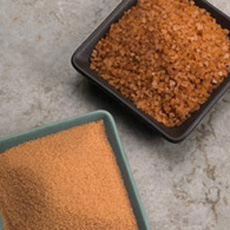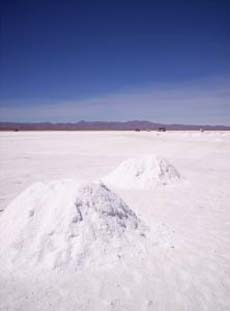

Alaea Sea Salt is a traditional Hawaiian table salt used to season and preserve. Alaea is a natural mineral volcanic baked red clay, added to enrich the salt with iron oxide. Photo courtesy of Saltworks.us, a wonderful resource for many types of gourmet salts. See more salts in our Salt Glossary.
June 2006
Updated November 2008
|
 |
Product Reviews / Main Nibbles / Seasonings
A Brief History of Salt
Page 3: The Chemistry Of Salt
This is Page 3 of a four-page article. Click on the black links below to visit other pages.
The Chemistry of Salt
Sodium chloride, or common table salt, is the chemical compound NaCl—one sodium ion bound to one chlorine ion (chemically, it is 60.663 percent elemental chlorine [Cl] and 39.337 percent sodium [Na]). Saltiness is a taste produced by the presence of sodium chloride (and to a lesser degree other salts). The ions of salt, especially sodium, can pass directly through ion channels in the tongue.
 In chemical terms, salt is one of the most basic molecules on earth. It’s also one of the most plentiful. It has been estimated that salt deposits under the state of Kansas alone could supply the entire world’s salt needs for the next 250,000 years. In chemical terms, salt is one of the most basic molecules on earth. It’s also one of the most plentiful. It has been estimated that salt deposits under the state of Kansas alone could supply the entire world’s salt needs for the next 250,000 years.
Salt occurs naturally in many parts of the world as the mineral halite (rock salt) and as mixed evaporites in salt lakes. Underground salt deposits are found in both bedded sedimentary layers and domal deposits (hence, salt mines). Some salt is on the surface, the dried-up residue of ancient seas (like the famed Bonneville Salt Flats in Utah). Seawater contains an inexhaustible supply of salt (salt represents about 77 percent of the Total Dissolved Solids in the water). Photo of Salar de Uiuny, Bolivia by Gabriella Silvestrini | SXC.
Sodium chloride crystals are cubic in form—the salt crystal is often used as an example of crystalline structure. It varies in color from colorless, when pure, to white, grey or brownish, depending on what trace minerals are in the salt deposits...as we’ll see in the next section.
Information from the Salt Institute and Cargill Salt.
Continue To Page 4: Sea Salt
Go To The Article Index Above
Lifestyle Direct, Inc. All rights reserved. Images are the copyright of their respective owners.

|





 In chemical terms, salt is one of the most basic molecules on earth. It’s also one of the most plentiful. It has been estimated that salt deposits under the state of Kansas alone could supply the entire world’s salt needs for the next 250,000 years.
In chemical terms, salt is one of the most basic molecules on earth. It’s also one of the most plentiful. It has been estimated that salt deposits under the state of Kansas alone could supply the entire world’s salt needs for the next 250,000 years. 